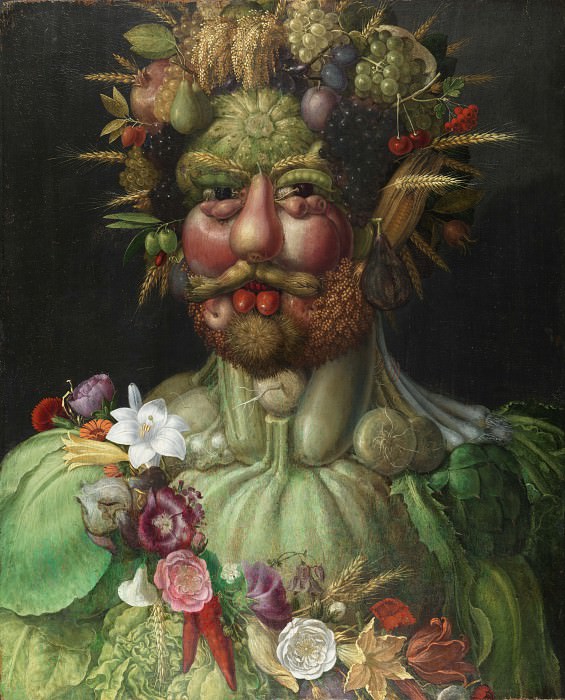Vertumnus (Emperor Rudolf II) Giuseppe Arcimboldo (1526-1593)
Giuseppe Arcimboldo – Vertumnus (Emperor Rudolf II)
Edit attribution
Download full size: 7421×9200 px (7,7 Mb)
Painter: Giuseppe Arcimboldo
Location: Skokloster Castle, Habo Municipality (Skoklosters slott).
Giuseppe Arcimboldo was a prominent painter and decorator from Milan and the grandson of the Archbishop of Milan. The artist lived in 16th-century Italy and served the Habsburg dynasty in Bohemia and Austria, and during the reign of Ferdinand I in Vienna he was appointed portrait-copier. Later, when Ferdinand I’s eldest son Maximilian succeeded to the throne, he became a court painter. He knew a great deal about the benefits of food.
Description of Giuseppe Arcimboldo’s Portrait of Emperor Rudolph II as Vertumnus
Giuseppe Arcimboldo was a prominent painter and decorator from Milan and the grandson of the Archbishop of Milan.
The artist lived in 16th-century Italy and served the Habsburg dynasty in Bohemia and Austria, and during the reign of Ferdinand I in Vienna he was appointed portrait-copier.
Later, when Ferdinand I’s eldest son Maximilian succeeded to the throne, he became a court painter. He knew a great deal about the benefits of food. He painted many pictures created from fruits and vegetables, from which he also created portraits of people.
This portrait shows Emperor Rudolph II as Vertumnus, the god of seasons and earthly fruits, who was known in ancient Italy. Vertumnus was the god of transformations, the metamorphosis of natural abundance.
This work by Giuseppe Arcimboldo is one of the most famous of all the portraits of this emperor, because this portrait by the Italian artist presents Rudolph II as the twirling god Vertumnus from ancient Rome, who is composed of different berries, fruits and vegetables.
Vertumnus" is a half-length portrait of the emperor composed of various fruits and vegetables, which represent vegetation and the gifts of nature. This painting was appreciated by the emperor himself and generously rewarded the painter. His friend, the scholar and writer Gregorio Camanini described it as follows: his eyes were like the star of Olympus, his chest he called air, his belly the earth, his feet the abyss, and his clothes seemed to him woven of fruit and grass.
In the painting of this artist, fruits and vegetables allow to embody a certain idea and idea of the master. I would also like to note that this is not the only painting by Giuseppe in which he uses products to create his pictorial images.
Кому понравилось
Пожалуйста, подождите
На эту операцию может потребоваться несколько секунд.
Информация появится в новом окне,
если открытие новых окон не запрещено в настройках вашего браузера.
You need to login
Для работы с коллекциями – пожалуйста, войдите в аккаунт (open in new window).




















COMMENTS: 1 Ответы
УЧЕБНИК СМЫСЛА
Учебник смысла я листаю,
Его читаю днём любым.
Его читаю, постигаю,
Он языком дан непростым.
Мне интересно снеговое
Круженье и блистанье – в нём
Серебряное, золотое
Мерцает дорогим огнём.
Мне интересно для чего же
Существование моё?
Пусть я живу, вопросы множа,
Ответы есть. Душа поёт.
Учебник смысла я листаю
И днём и ночью – и за ним
Величье Воли постигаю.
И сам я становлюсь другим.
You cannot comment Why?